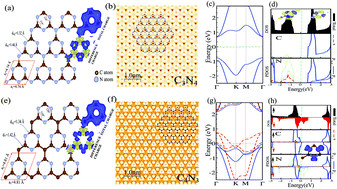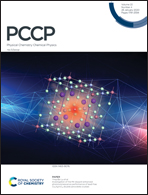Control of C3N4 and C4N3 carbon nitride nanosheets’ electronic and magnetic properties through embedded atoms†
Abstract
In the present work, the effect of various embedded atom impurities on tuning electronic and magnetic properties of C3N4 and C4N3 nanosheets have been studied using first-principles calculations. Our calculations show that C3N4 is a semiconductor and it exhibits extraordinary electronic properties such as dilute-magnetic semiconductor (with H, F, Cl, Be, V, Fe and Co); metal (with N, P, Mg and Ca), half-metal (with Li, Na, K, Al, Sc, Cr, Mn, and Cu) and semiconductor (with O, S, B, C, Si, Ti, Ni and Zn) with the band gaps in the range of 0.3–2.0 eV depending on the species of embedded atom. The calculated electronic properties reveal that C4N3 is a half-metal and it retains half-metallic character with embedded H, O, S, F, B, N, P, Be, Mg, Al, Sc, V, Fe, Ni and Zn atoms. The substitution of Cl, C, Cr and Mn atoms create ferromagnetic-metal character in the C4N3 nanosheet, embedded Co and Cu atoms exhibit a dilute-magnetic semiconductor nature, and embedded Ti atoms result in the system becoming a semiconductor. Therefore, our results reveal the fact that the band gap and magnetism can be modified or induced by various atom impurities, thus, offering effective possibilities to tune the electronic and magnetic properties of C3N4 and C4N3 nanosheets.



 Please wait while we load your content...
Please wait while we load your content...